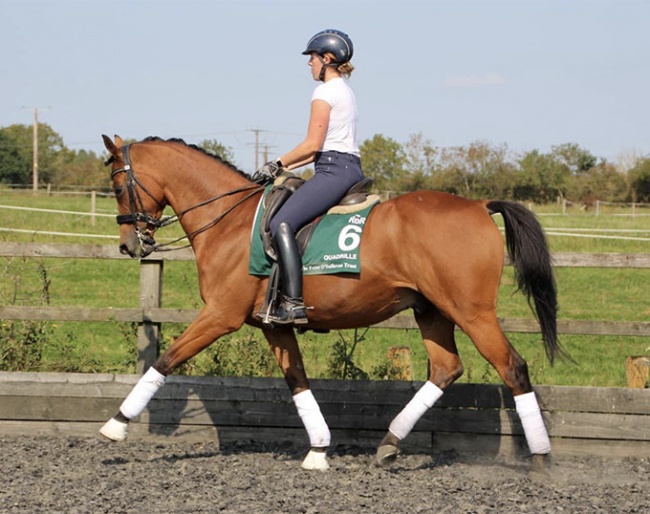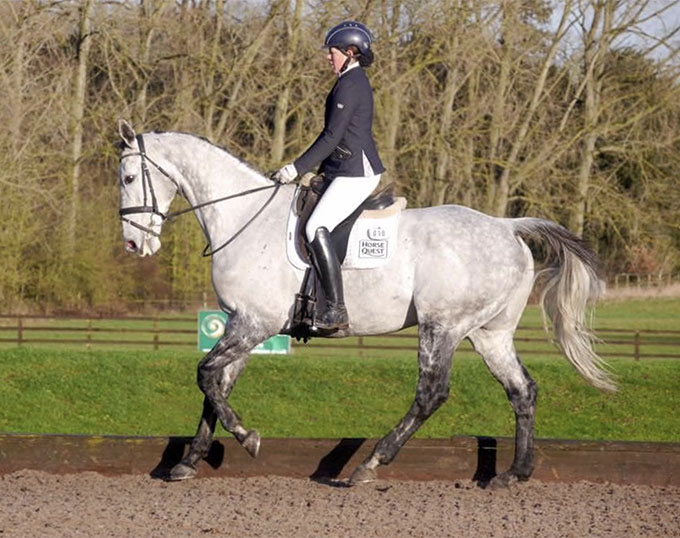
This interview is a continuation of the series "From Flying Past to Flying Change: Thoroughbreds in Dressage Competition."
Read Part I (introduction), Part II (TB between Wars), Part III (Post War, 1960s), Part IV (TB losing relevance), Part V (1970s), and Part VI (1980-1990s). Read an Interview on Thoroughbreds with Monica Theodorescu, Rozzie Ryan, and Sue Gallagher.
Being Successful with Thoroughbreds - Two Examples of Our Days
While there had been distinct thoroughbred dressage riders in the past, such as Sweden’s Henri St. Cyr in the 1950s and early 1960s, these horses could also now and then be found in professional dressage stables in the first three decades after the war.
Nowadays to find a thoroughbred competing at advanced, let alone FEI-level is almost like finding the needle in the haystack.
Louise Robson
Eurodressage spoke with Louise Robson (33) who has competed several OTTB at advanced level and whose current top horse Quadrille xx (by Danehill Dancer xx) is not only bred and owned by HM Queen Elizabeth II, but has won up to Inter I level and working towards Grand Prix.
After having trained one of her previous thoroughbreds at Monica Theodorescu’s stable and having worked as Monica’s traveling groom, Louise founded „Thoroughbred Dressage“ in 2013. This training and dressage stable at Padbury near Buckingham in Great Britain might be pretty unique as it focuses on retraining and competing OTTB in dressage.
ED: When did you found your stable and why does it focus on training thoroughbreds into dressage?

retrained him into a successful M-level dressage horse.
ED: To the best of my knowledge you are the only training stable of this kind. Is there a lot of request for that sort of training in Great Britain?
Louise Robson: For me the difficulty is finding owners or people wanting to invest in the ‘long run’ of retraining their ex racehorse into dressage. The support for showing and eventing is a lot greater as the rewards, from an owner’s perspective, is bigger. The shows are bigger and exciting to watch. Dressage can take years and there is no guarantee of a win or a placing against the warmbloods.
There is a lot of training requests of people at the lower levels, or for horses just starting their retraining. We have some horses come in for training that are due to go eventing and need some help on the flat. The number of thoroughbreds at higher levels are very very small as anything past medium level requires the conformation of most of the thoroughbred to be challenged.
ED: Most of your horses somehow "found" you. But if you are looking for a thoroughbred for dressage, what are you looking for?

ED: You are successfully training warmbloods and thoroughbreds alike. Where are the most significant differences when you train them through the levels?
Louise Robson: I find the most significant differences are the speed of learning, the workmanship and the natural ability. With the warmbloods I find the learning rate to be a little slower than that of a thoroughbred. With a thoroughbred the early years are the hardest as mentally they take everything on and their brains soak everything up like a sponge. It is hard to keep the brain occupied and focused whilst the body catches up with the changes in their way of going, muscular developments etc. A thoroughbred will work so hard for you and try to give you everything (sometimes a little too much). As the advanced work develops the rate at which they learn and understand things is far superior to that of a warmblood. Sometimes with the warmblood we have to break everything down just that bit more to make it a little more comprehensive.
It is no lie that one of the joys of working with the warmbloods is that once the foundations are secure, developing the work is easier than the thoroughbred as the conformation allows the body to work, connect and ultimately express themselves very well. For the thoroughbred the connection is always very hard to achieve, their conformation doesn’t naturally allow them to.
ED: England is THE Thoroughbred country, but even the xx horse has disappeared from higher level dressage. Do you need a warmblood today to really succeed?

them the prestigious Cheltenham Gold Cup and the Grand
National, before he took on a second career with
eventing rider Charlotte Alexander. Robson helps with
his dressage.
They will give you much ‘success’ in the dressage arena from grass roots to national level, it is our responsibility to guide, train and develop them and not compare them to the finely bred, naturally gifted moving warmblood, but to allow them to shine in their own light for who they are.
Text © Eurodressage - Photos © Chantal Wooten - private
Related Links
Louise Robson on a Mission Appointed by Her Majesty
From Flying Past to Flying Change - Part VI: The Thoroughbred in the 1980s and 1990s
From Flying Past to Flying Change - Part V: The Thoroughbred in the 1970s
From Flying Past to Flying Change - Part IV: On Thoroughbreds Losing Relevance in Dressage
From Flying Past to Flying Change - Part III: The Thoroughbred from the Post-War Times into the 1960s
From Flying Past to Flying Change - Part II: Thoroughbred Champions Between the Wars
From Flying Past to Flying Change - Part I: Thoroughbreds in Dressage Competition